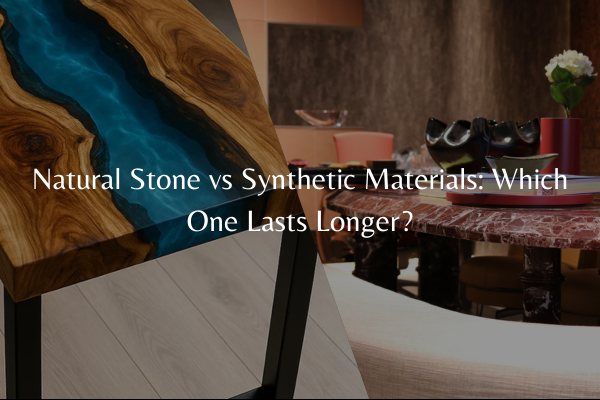 ">
">
Natural Stone vs Synthetic Materials: Which One Lasts Longer?
When planning an interior or exterior design project, one of the key decisions you’ll face is choosing the right material. Two of the most popular options in the market today are natural stone and synthetic materials (such as solid surface, porcelain, vinyl, or engineered stone).
But the big question is: Which material is more durable in the long run?
In this article, we’ll give you a detailed comparison of natural stone vs synthetic materials, covering durability, strengths, weaknesses, and aesthetics — helping you make the best decision for your project.
What Is Natural Stone?
Natural stone is a material sourced directly from geological processes, without industrial manufacturing. Popular premium types of natural stone used in interior design include:
- Marble
- Granite
- Onyx
- Quartzite
- Travertine
- Slate
Each type of stone has its own unique veining, texture, and hardness level, making it an exclusive material often used in luxury homes, hotels, and villas.
What Are Synthetic Materials?
Synthetic materials are man-made products produced through chemical or industrial processes. Common examples include:
- Solid Surface (acrylic resin and mineral blend)
- Engineered Stone (typically quartz-based with resin)
- Modern Porcelain or Ceramic
- Vinyl and laminates
Synthetic materials are designed to mimic the look of natural stone or wood, but with more affordable production costs and easier installation.
Durability Comparison: Natural Stone vs Synthetic Materials
1️⃣ Scratch Resistance
- Natural Stone:
- Granite and Quartzite are highly scratch-resistant (Mohs hardness scale 6-7).
- Marble and Onyx are softer (Mohs 3-5) and require extra protection.
- Synthetic Materials:
- Solid surface is more prone to scratches but can be re-polished.
- Engineered stone offers good scratch resistance depending on quality.
2️⃣ Heat Resistance
- Natural Stone: Excellent heat resistance, especially Granite and Quartzite — ideal for kitchen countertops.
- Synthetic Materials: Can soften or get damaged if exposed to high heat (above 150–200 °C). Use protective pads.
3️⃣ Stain Resistance
- Natural Stone: Porous surface requires regular sealing to prevent stains.
- Synthetic Materials: Non-porous surface — easier to clean and more resistant to daily stains.
4️⃣ Chemical Resistance
- Natural Stone: Sensitive to acidic substances (vinegar, lemon), especially Marble and Onyx.
- Synthetic Materials: Generally more resistant to mild chemicals, though resins in engineered stone can degrade under strong chemicals.
5️⃣ Long-Term Durability (Decades)
- Natural Stone: With proper care, can last decades or even centuries — proven by historic buildings still standing today.
- Synthetic Materials: Typical lifespan of 10–25 years, depending on material quality, usage, and maintenance.
Aesthetics & Investment Value
Natural Stone
- Offers unique, luxurious appearance due to natural patterns that cannot be fully replicated by synthetic products.
- Adds property value — viewed as a premium material.
- Each slab has a distinctive look, making each project feel personal and exclusive.
Synthetic Materials
- Offers consistent color and pattern — great for modern, uniform designs.
- Available in a wide variety of colors, including some shades difficult to find in natural stone.
- Ideal for budget-conscious projects or areas needing a non-porous surface.
Maintenance
- Natural Stone: Requires regular sealing (especially for Marble, Onyx, and Travertine) and cleaning with pH-neutral products.
- Synthetic Materials: Easier to maintain daily — wipe with a damp cloth and mild cleaner.
Conclusion: Which One Lasts Longer?
If we’re talking purely about long-term durability, natural stone clearly outperforms synthetic materials — as long as you are willing to maintain it properly. Stones like Granite and Quartzite can even be passed down to future generations.
However, if you need a practical, low-maintenance, and budget-friendly solution, synthetic materials are also an excellent choice — especially for areas prone to stains or heavy usage.





